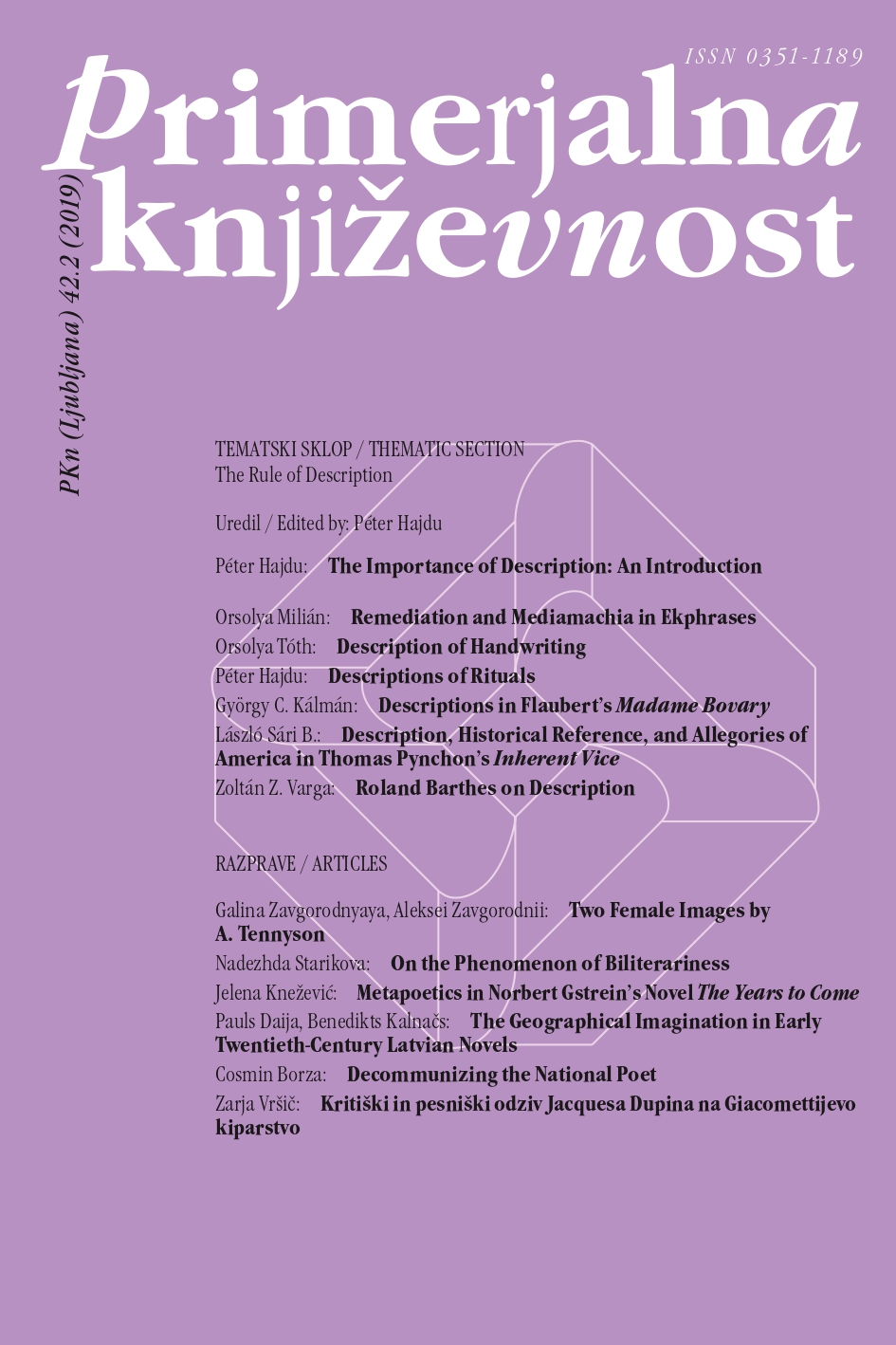Description of Handwriting: Physiognomic Portraits in Nineteenth-Century Novels
Keywords:
narratology, the novel, nineteenth century, narrative technique, physiognomy, handwriting, description, Lavater, Johann KasparAbstract
The article examines a specific type of description: that of a character’s physical features, or, in the broader sense, the possibility of ekphrasis in narrative. First of all, I focus on how the looks of persons – characters – are rendered in the nineteenth-century novel. Then I turn to the means and functions of describing handwriting. Recently corporeal narratology has emphasized that the representation of human bodies within a narrative is always determined by the fact that the body image is historically and culturally constituted. In the nineteenth century the key components of this cultural context were provided by J. C. Lavater writings on physiognomy. Relying on the terminology of Graeme Tytler I reconceptualize, in the language of narratology, the emergence of the post-Lavaterian portrait.References
Austen, Jane. Pride and Prejudice. London: R. Bentley, 1853.
Austen, Jane. Emma. London: R. Bentley, 1841.
Bacsó, Béla. “Phüszisz és Idea: Schiller korai műveihez.” Alföld 57.1 (2006): 57–66.
Bal, Mieke. “Description as Narration.” On Story-Telling. Essays in Narratology. Ed. David Jobling. Sonoma: Polebridge Press, 1991. 109–146.
Békés, Enikő. “Mutasd az orrod, s megmondom ki vagy, avagy miről írnak a fiziognómusok.” Ókor 2.2–3 (2003): 58–64.
Békés, Enikő. “Pál apostol fiziognómiája.” Természeted az arcodon. A fiziognómia története. Az ókortól a XVII. századig. Ed. Éva Vígh. Szeged: JATEPress, 2006. 381–414.
Belting, Hans. Faces. Eine Geschicte des Gesichts. Munich: C.H. Beck, 2013.
Berland, Kevin. “Inborn Character and Free Will in the History of Physiognomy.” Physiognomy in Profile. Lavater’s Impact on European Culture. Eds. Melissa Percival and Graeme Tytler. Newark: University of Delaware Press, 2005. 25–38.
Berthelot, Francis. Le corps du Héros. Pour une sémiotique de l’incarnation Romanesque. Paris: Nathan, 1997.
Brontë, Emily. Wuthering Heights. Ed. Beth Newman. Peterborough: Broadview Press, 2007.
Craig, Charlotte M. “A Rigid Issue: Lichtenberg versus Lavater.” Anthropology and the German Enlightenment. Perspectives on Humanity. Ed. Katherine M. Faull. Lewisburg: Bucknell University Press, 1995. 57–76.
Czifra, Mariann. “Érzelmek hálójában.” A Vörös postakocsi online. Web 22 January 2018.
Debreczeni, Attila. “Kazinczy, a dokumentátor.” Irodalomértelmezések a felvilágosodástól napjainkig. Ed. Egyed Emese. Kolozsvár: Egyetemi Műhely Kiadó, 2014. 281–289.
– – –. “Kazinczy emlékállító archívuma 1802–1803-ból.” Irodalomtörténeti Közlemények 118.2 (2014): 226–244.
Dickens, Charles. Great Expectations. Boston: Estes and Lauriat, 1881.
Erle, Sybille. Blake, Lavater and Physiognomy. New York: Routledge, 2010.
Eco, Umberto. “Az arc nyelvezte.” Fordította Kunkli Enikő. Magyar Lettre Internationale 53 (2004): 19–25.
Földes, Györgyi. “Jeltől a testig. A klasszikus narratológia találkozása a korporálissal.” Irodalomismeret 27.1 (2015): 5–29.
Goethe, Johann Wolfgang. Elective Affinities. Boston: D.W. Niles, 1872.
– – –. The Autobiography of Goethe. Truth and Poetry: From My Own Life. II. Ed. Parke Godwin. New York: Wiley and Putnam, 1849.
Graham, John. Lavater’s Essays on Physiognomy. Frankfurt am Main: Peter Lang, 1979.
Gray, Richard T. About Face. German Physiognomic Thought from Lavater to Auschwitz. Detroit: Wayne State University Press, 2004.
Gyimesi, Emese. “Szendrey Júlia versgyűjteménye a Magyar Tudományos Akadémia Kézirattárában.” Irodalomtörténeti Közlemények 116.1 (2012): 83–91.
Hamon, Philippe. “Qu’est-ce qu’une description?” Poétique 12 (1972): 465–485.
Jókai, Mór. Politikai divatok. I. Pest: Emich Gusztáv, 1862.
– – –. Egy magyar nabob. II. Budapest: Franklin-Társulat, 1875.
– – –. A tengerszemű hölgy. Budapest: Akadémiai, 1972.
Jósika, Miklós. Abafi. Tran. Zsuzsanna Tamás. Manassas: Payne Publishing, 2013.
Kazinczy, Ferenc. Kazinczy Ferenc Levelezése. Vols. 1–21. Ed. János Váczy. Budapest: Magyar Tudományos Akadémia, 1890–1911.
– – –. Pályám emlékezete. Ed. László Orbán. Debrecen: Debreceni Egyetemi Kiadó, 2009.
Kucserka, Zsófia. Könyvbe vésett jellemek. Szereplői karakter Kemény Zsigmondnál és a 19. századi magyar regényben. Budapest: Ráció, 2017.
Lavater, Johann Caspar. Essays on Physiognomy. Designed to Promote Knowledge and the Love of Mankind. To Which Are Added One Hundred Physiognomical Rules. Tran. Thomas Holcroft. London: Cowie, Low and Co., 1826.
– – –. Essays on Physiognomy. Tran. Thomas Holcraft. London: William Tegg and Co., 1878.
– – –. Pysiognomische Fragmente, zur Beförderung der Menschenkenntniß und Menschenliebe. Vol. III. Liepzig: Weidmann und Reich, 1777.
Lichtenberg, Georg Christoph. Schriften zum Physiognomik-Streit. Über Physiognomik wider die Physiognomen. Fragment von Schwänzen. Ed. Karl Riha. Giessen: Anabas-Verlag Kämpf, 1970.
Lombroso, Cesare. L’uomo delinquente. Turin: Bocca, 1889.
Mikes, Lajos and Dernői Kocsis, László. Szendrey Julia ismeretlen naplója, levelei és haláloságyán tett vallomása. Eds. Lajos Mikes and László Dernői Kocsis. Budapest: Genius, 1930.
Mitchell, W. J. Thomas. “Ekphrasis and the Other.” Picture Theory. Chicago: The University of Chicago Press, 1995. 151–208.
Moore, Evelyn K. “Goethe and Lavater. A Specular Friendship.” The Enlightened Eye. Goethe and Visual Culture. Eds. Evelyn K. Moore and Patricia Anne Simpson. Amsterdam: Rodopi, 2007. 165–193.
Percival, Melissa. The Apperance of Character. Physiognomy and Facial Expression in Eighteenth-Century France. London: W. S. Maney & Son, 1999.
Polcz, Alaine. Egész lényeddel. Pécs: Jelenkor, 2006.
Punday, Daniel. Narrative Bodies. Toward a corporeal narratology. New York: Palgrave Macmillan, 2003.
Stendhal. The Red and the Black. A Chronicle of the 19th Century. Tran. Horace B. Samuel. Auckland: Floating Press, 2014.
Stevenson, Robert Louis. “Strange Case of Doctor Jekyll and Mr. Hyde.” The Strange Case of Doctor Jekyll and Mr. Hyde and Other Stories. London: Collector’s Library, 2004.
Szauder, József. “A kassai Érzelmek iskolája.” A romantika útján. Budapest: Szépirodalmi, 1961. 90–114.
– – –. “Veteris vestigia flammae. Kazinczy szerelme.” Az estve és Az álom. Budapest: Szépirodalmi, 1970. 347–433.
Tóth, Orsolya. “Az arc olvasása? Fiziognómai szemlélet a 19. századi magyar irodalomban.” Bölcsész Akadémia 2. Eds. Böhm Gábor and Fedeles Tamás. Pécs: PTE, 2015. 27–45.
Tytler, Graeme. Physiognomy in the European Novel. Faces and Fortunes. Princeton: Princeton University Press, 1982.
– – –. “Physiognomy and the Treatment of Beauty in Jane Eyre.” Brontë Studies 41.4 (2016): 300–311.
– – –. “Physiognomy in Wuthering Heights.” Brontë Studies 21.4 (1994): 137–148.
– – –. “‘Faith in the Hand of Nature.’ Physiognomy in Sir Walter Scott Fiction.” Studies in Scottish Literature 33.1 (2004): 223–246.


